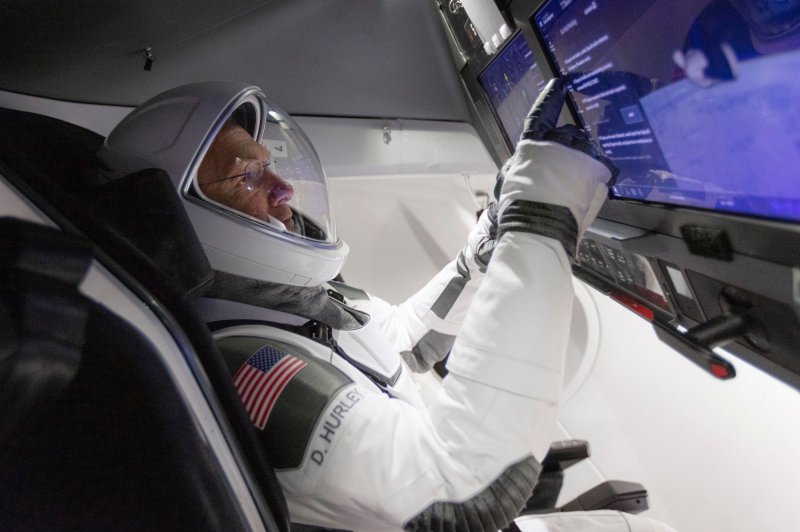1 of 4 | NASA astronaut Doug Hurley, shown on Jan. 13, trains for Wednesday's launch to the International Space Station in the Crew Dragon capsule. File Photo courtesy of SpaceX |
License Photo
ORLANDO, Fla., May 21 (UPI) -- The Crew Dragon space capsule made by Elon Musk's SpaceX faces a final big test when two astronauts get on board to fly to the International Space Station next week.
The United States hasn't had the capability to launch astronauts from U.S. soil since the last space shuttle mission in 2011. Since then, astronauts have flown to the space station only on Russian rockets launched from Kazakhstan.
A successful mission for Crew Dragon, which is to lift off atop a Falcon 9 rocket Wednesday, will restore that capability and continue the nation's dominance in space, along with making scientific advances from space exploration.
The flight, called Demo 2, is designed to certify the Crew Dragon for regular ferry service of astronauts to the space station.
"I think it's an outstanding flying machine," astronaut Doug Hurley said upon arrival at Kennedy Space Center on Wednesday. He will be flight commander for the mission. He and Bob Behnken, the other astronaut on the flight, each have two space shuttle missions on their résumés.
"It is definitely not the space shuttle, in many ways," Hurley said of the capsule. "It's much smaller, but it's a capsule. It's state of the art from a technology standpoint."
Hurley and Behnken had trained in simulators at SpaceX's headquarters for months. Among the completely new features of the spacecraft are a touchscreen control panel, rather than a traditional hand controller like the shuttles had.
The Falcon 9 is to lift off at 4:33 p.m. EDT, May 27, from Kennedy Space Center's Complex 39A. That site, from which many previous Apollo and space shuttle missions were launched, is being leased by SpaceX.
"This will be the first time humans have ridden on the Falcon 9, even though it has flown many times," Hurley said in previous NASA interviews.
"And so just taking in that experience and the sounds, and all those things that we can relay to future crews, and how the vehicle reacts during the launch process -- is going to be something important to do, too."
NASA's urgent need is to stop relying on Russian Soyuz rockets to carry U.S. astronauts to the space station -- at a cost of more than $70 million per seat.
SpaceX is over two years behind schedule for the launch. NASA awarded two finalist contracts in 2014 to certify new spacecraft to carry people by 2017 -- Boeing got $4.2 billion for its Starliner capsule and SpaceX got $2.6 billion for Crew Dragon.
A sobering report from the U.S. Government Accountability Office in June noted that both programs were making progress, but also said continued delays create "continued uncertainty about when either contractor will be certified to begin conducting operational missions to the ISS."
SpaceX said Crew Dragon is capable of carrying up to seven passengers to and from Earth orbit, and beyond. The capsule is about 13 feet in diameter and 26.7 feet high, and can carry 13,228 pounds at launch. Flight suits include a 3D-printed helmet and touchscreen-compatible gloves.
To prepare for this mission, SpaceX blew up a rocket in January in a final uncrewed test launch of the capsule, proving it could carry astronauts to safety in a launch emergency.
At the time, Musk said sensors aboard the capsule showed astronauts would have experienced a maximum of 3.5 times Earth's gravity. That compares to nearly seven Gs endured by people on a Russian Soyuz capsule that aborted in October 2018.
SpaceX already has sent uncrewed cargo Dragons on resupply missions to the space station several times.
NASA astronaut Douglas Hurley (C) waves to onlookers as he boards a plane at Naval Air Station Pensacola to return him and NASA astronaut Robert Behnken home to Houston a few hours after the duo landed in their SpaceX Crew Dragon Endeavour spacecraft off the coast of Pensacola, Fla,, on August 2, 2020. Photo by Bill Ingalls/NASA |
License Photo
















